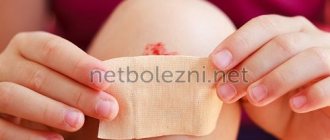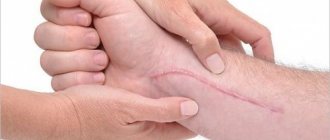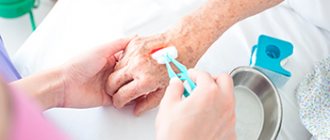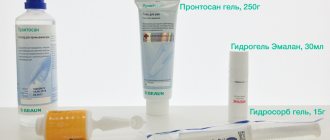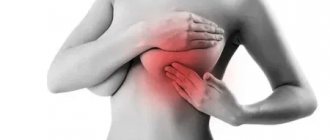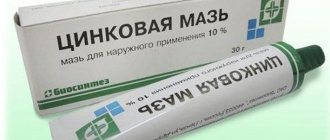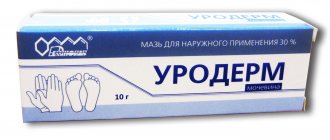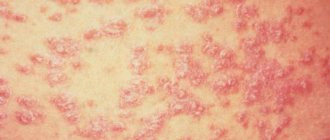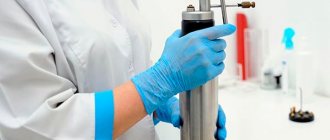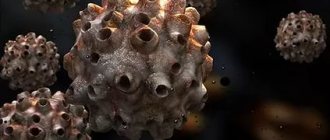From this article you will learn:
- the best ointment for scars and scars on the face and body,
- products with proven effectiveness,
- laser scar removal – prices, before and after photos,
- scar after cesarean section - photo, how to treat.
The article was written by a specialist with higher medical education.
A scar is an area of fibrous tissue that forms on the skin after damage, such as trauma, surgery, or inflammation. Scar formation on the skin is a natural part of the wound healing process, i.e. regeneration process. Fibroblasts take the main part in this process, because It is these cells that synthesize collagen, which primarily consists of both our skin and scar tissue.
It must be said that the appearance of the future scar will largely depend on what happens to the wound, starting from the moment the skin is damaged - until the moment it is completely healed (this period is 2-3 weeks). It is during this period that the doctor has the opportunity to prevent excessive scarring. But as we said above, scars on the skin can occur not only as a result of injury, but also after inflammatory skin diseases. In this case, we mean scars after smallpox, chickenpox or acne on the face (Fig. 6).
Scars/scars: photo
Pathological scars with excess scar tissue (Fig. 2-3) most often occur after a wound becomes infected, if the wound was sutured with excessive tension on the sutures, or the wound itself was located in an area of skin with high natural tension. We are talking about the neck, shoulders, sternum, areas of the body near the joints. Deterioration of the appearance of the scar can also be caused by late removal of sutures, as well as too long epithelization of the wound (more than 2 weeks).
Cream or ointment for scars and scars - can be used after complete epithelization of the wound surface, when the period of scar maturation begins. Typically this period begins 14-21 days after the wound occurs and will last from several months to an average of 1 year (depending on the size of the wound/scar). During the maturation period, the size of the scar begins to shrink, its redness decreases - due to a decrease in the number of capillaries. And it is during this period that scar cream is more likely to produce results.
Important: the main purpose of using ointment for scars and scars is to reduce the likelihood of pathological scarring (the appearance of hypertrophic scars). Below you will see that to date there is no scientific research that would unequivocally confirm the effectiveness of topical products for reducing scars. The results of clinical studies contradict each other, but researchers agree that the use of ointment for scars still increases the likelihood of a more favorable outcome.
Types of scars (scars) –
Scars on the skin are usually divided into several categories. There are normotrophic, hypertrophic, keloid and atrophic scars/scars.
- Normotrophic scars (Fig. 1) are flat, pale scars, which are an example of normal scarring (most patients experience these). They differ in that they are flush with the surface of the skin, or protrude very slightly above it. At first they will be red or dark red in color, but over time they will become increasingly paler and flatter.
- Hypertrophic scars (Fig. 2-3) - they are distinguished by the fact that they will noticeably rise above the skin level, plus they almost always have an intense red or purple color - due to the presence of a large number of capillaries. They begin to form 2-3 weeks after complete epithelization of the wound, and within 3-4 months their growth is noted (after which further correction downward is possible). By about 1-1.5 years, their sizes become stable and do not change further.
Hypertrophic scar from cesarean section –Hypertrophic scars are an example of a pathological variant of tissue scarring and, as a rule, they are formed after skin incisions are made during surgical operations. Hypertrophy of scar tissue can be a consequence of infection of the wound, or when the surgeon sutured the wound with excessive tension on the surrounding tissue, or if the wound is located in an area of the skin with high natural tension (neck, shoulders, near joints), etc.
- Keloid scars/scars (Fig. 5) – are formed as a result of excessive collagen formation at the wound site. The peculiarity of these scars is that scar tissue continues to grow far beyond the wound itself - even after the wound has already healed. Moreover, if hypertrophic scars are still capable of reduction and can be smoothed out over several years, then the size of keloid scars does not change over time.
- Atrophic scars (Fig. 6) - they look like indentations on the surface of the skin (minus tissue), i.e. located below the surface of the skin. This is what scars on the face look like after chickenpox or acne. The treatment of atrophic scars has significant differences from the treatment of other types of scars, and you can read more about this in the article at the link above.
How does scar formation occur?
Scar formation is a natural healing process of the skin after damage (Fig. 7). Initially, the wound surface becomes covered with crusts, and the traumatic defect itself begins to be filled with soft granulation tissue. Gradually, the granulation tissue is replaced by dense fibrous connective tissue (collagen), which is produced by cells called fibroblasts.
Fibroblasts actively produce collagen at the site of skin damage for 3-4 months, which usually leads to a gradual elevation of the scar above the skin level and the formation of a bumpy surface. At the same time, blood capillaries actively grow, causing the scar to become red. Over time, the over-formed collagen begins to gradually break down, and the number of capillaries decreases (the scar decreases in size, becomes smooth, less hard and more elastic, less red).
The period of scar maturation - we have already said above that external cream or ointment for scars and scars - can only give an effect if they are used during the period of scar maturation, during which the scar undergoes active transformation. For example, if at the beginning of this period the scar only increases in size and becomes redder, then over time its reverse transformation begins to occur. Gradually, the scar decreases in size (due to the degradation of excess collagen), and after an average of 7 months it begins to fade due to a decrease in the number of capillaries.
The period of scar maturation begins from the moment of complete epithelization of the wound surface (when there are no longer crusts), and will last on average up to 1 year. But in some patients this period can take only 4-6 months, and in rare patients it can take up to 2 years, and this difference in time depends on several factors. For example, the size of the original wound/scar size, whether there is skin tension in the scar area, and age (patients under 30 years of age have a slower rate of scar maturation than patients over 55 years of age).
Important: Clinical studies show that the slower the rate of scar maturation, the worse its final appearance.
How to get rid of scars -
How to get rid of scars will depend on the type of scar, as well as its age. There are several treatments that can help make them less noticeable and improve their appearance. Keep in mind that, unfortunately, it is hardly possible to improve, but completely get rid of scars without a trace.
In this section of the article we will focus on –
- cream for scars and scars (Dermatix, Kelo-Kote),
- silicone bandages (plasters),
- scar massage and pressure bandages,
- laser scar removal,
- surgical removal of scars.
Also used to treat scars are:
- medium or deep chemical peeling,
- dermabrasion technique (skin resurfacing),
- cosmetic camouflage (make-up or tattoo on scars).
How to inject Solcoseryl for gastritis
Gastritis is a disease of the gastric mucosa that can occur for various reasons. Solcoseryl ampoules will not become the main drug used in the treatment of gastritis, but it can speed up the healing process, while the prescribed therapy will relieve the patient of the source of the problem.
The gastric mucosa can become inflamed not only as a result of poor nutrition, but also as a result of infection with gastrointestinal infections. The attending physician will first conduct an examination and evaluate the test results, which will allow him to prescribe effective therapy. Solcoseryl will be used as an addition to the main treatment, as it will help the stomach tissues to regenerate faster, ulcers to heal, and inflammation to disappear.
The best external remedy for scars and scars -
We have already said above that external preparations will be effective only if they are used during the period of scar maturation (24stoma.ru). Moreover, an ointment or cream for scars and scars must be used for at least 2-3 months before you can notice the first results. If you missed the period of scar maturation, then external remedies will not be effective and you will need more radical treatment methods (for example, laser). Let's look further at what external means we can use to get rid of scars.
1) Remedies for scars and scars based on silicone -
Scar products based on medical silicone have been used since approximately 1983. Silicone gels work on the principle of occlusion and hydration. After applying silicone to the surface of the skin, it is absorbed, leaving an invisible “occlusive bandage” on the surface (this layer prevents the evaporation of water from the surface of the skin/scar, but at the same time allows air to pass through). As a result, this increases the hydration of scar tissue, i.e. saturating it with water reduces the growth of blood capillaries.
As a result, this has a positive effect on the restructuring of the scar during its maturation, which increases the likelihood of reducing its size (while simultaneously improving such indicators as elasticity and extensibility). The hardness of the scar decreases, its color improves, and itching decreases. It must be said that in addition to silicone gels, there are also special silicone dressings that are worn from 12 to 23 hours daily - for several months.
- Gel Dermatix (USA) – costs 2,400 rubles per 15 g tube.
- Kelo-Coat gel (USA) – price 2400 rubles per 15 g tube.
- Zeraderm Ultra - price about 5,000 rubles per 20 g tube (this is an analogue of the first two drugs, but with a richer composition, which, in addition to silicone, additionally includes coenzyme Q10, vitamins A and E, as well as SPF 15).
The silicone dressings we talked about above are made on a fabric basis and are translucent. They have multiple uses, i.e. you don't need to change it to a new one every day. Silicone dressings come in specific sizes, but you can cut the size you need with scissors. The silicone bandage should be on the skin for 13 to 23 hours daily; it can only be removed for antiseptic treatment of the skin and the bandage itself.
- Dermatix silicone dressing - price from 1,400 rubles (size 4x13 cm), about 5,000 rubles (size 13x25 cm).
2) Scar remedy based on onion extract –
Onion extract is used in the treatment of burns, hypertrophic and keloid scars. It contains the flavonoids quercetin and kaempferol, which have an inhibitory effect on fibroblast proliferation and collagen production, which directly affects the formation of scar tissue. In addition, onion extract increases the expression of MMP-1 (matrix metalloproteinases, which belong to endopeptidases - enzymes that destroy the extracellular matrix of connective tissue).
Matrix metalloproteinases tend to destroy newly formed pathological collagen, which makes up scar tissue. An example of a drug with onion extract is the Contractubex gel. It also contains sodium heparin, which increases the hydration of scar tissue, i.e. saturating it with water. The drug Contractubex (Germany) costs only about 600 rubles for a 20 g tube and about 1000 rubles for a 50 g tube.
3) Products with proteolytic enzymes –
There is a Russian drug Fermenkol, which contains a complex of proteolytic enzymes (collagenolytic proteases), as well as sodium heparin. It is understood that these enzymes should destroy the excessively formed pathological collagen that makes up hypertrophic and keloid scars. Fermenkol gel costs from 1,500 rubles per 30 g tube, but there is also a form in the form of a solution (for electrophoresis).
There are clinical studies that show that enzymes penetrate the skin quite poorly due to the large size of the molecules. Therefore, the most effective method is the use of Fermenkol solution in medicinal electrophoresis procedures (this method significantly increases the penetration of enzymes into the rumen). The phonophoresis technique with gel will be slightly less effective, and the most ineffective method is conventional gel applications. Therefore, it is better to use gel applications only during breaks between electrophoresis courses, and not as monotherapy.
Possible side effects and contraindications
Very rarely, urticaria, itching, redness, and marginal dermatitis appear at the site of application of solcoseryl. If such allergic reactions occur, it is recommended to stop using the ointment and consult a doctor to change the drug.
Solcoseryl is contraindicated in case of hypersensitivity to the components of the ointment. It is also recommended to use it with caution in patients prone to allergies.
Solcoseryl in cosmetology: effective fight against wrinkles
Women appreciated the effect of the drug on the condition of the skin, although the instructions do not contain instructions for using solcoseryl for the face. Based on it, recipes for many masks have been created that effectively even out skin tone, promote the healing of microtraumas, and solcoseryl also helps get rid of wrinkles.
Cosmetologists explain the effectiveness of solcoseryl as a cosmetic product by the pharmacological action of the drug. Stimulating metabolism in cells, collagen synthesis and activating tissue repair make it possible to use solcoseryl to combat wrinkles.
However, there are no studies that would confirm its effectiveness, which does not prevent the drug from being used in beauty salons and at home as part of a variety of face masks. Women consider the safety and low cost of procedures to be the indisputable advantage of cosmetics with the addition of solcoseryl.
Cosmetologists claim that solcoseryl ointment moisturizes and nourishes the skin, promotes the healing of small cracks and saturates cells with oxygen. The ointment is mixed with nourishing cream in a 1:1 ratio and the mixture is applied to the facial skin twice a week at night. Solcoseryl can be used undiluted as a face mask. The ointment is applied to the skin for 1.5 hours, after which it is washed off with warm water.
The ointment is especially effective as a lip balm. To do this, solcoseryl is mixed with your favorite balm and applied to the skin of the lips. This product helps to quickly restore damaged skin.
Scar cream: reviews of effectiveness
It makes no sense to search the Internet for reviews of ointment or cream for scars and scars, because... At the moment, almost 99% of all reviews on forums are hidden advertising and anti-advertising. There are hundreds of marketing agencies in Russia, whose thousands of employees (under the guise of consumers) write posts on forums about medications, cosmetics, toothpastes and other various products. Therefore, we will use the results of published scientific studies, which are available on the website of the National Library of Medicine.
In general, clinical studies (source) show that silicone-based products are indeed capable of somewhat reducing the volume of scars, reducing their hardness and increasing elasticity, as well as improving the color of hypertrophic scars and keloids. When used prophylactically on the area of surgical incisions, products with silicone are highly likely to prevent the development of pathological types of scars that occur with hyper-formation of scar tissue.
Regarding the effectiveness of drugs based on onion extract, there are 2 very large clinical studies (source), in which 771 and 1269 people took part. The study showed that Contractubex also led to an improvement in the appearance of hypertrophic and keloid scars, and when used prophylactically immediately after epithelization of the wound, it increased the likelihood that the scarring will not be pathological.
However, there are comparative studies of the effectiveness of products with silicone and onion extract. For example, “Comparison of efficacy of silicone gel, silicone gel sheeting, and topical onion extract including heparin and allantoin for the treatment of postburn hypertrophic scars” 2009, authors – Karagoz H., Yuksel F.. (translation – “Comparison of effectiveness silicone gel, silicone gel coating, and topical onion extract, including heparin and allantoin, for the treatment of hypertrophic burn scars.” This study concluded that onion extract formulations were slightly less effective than silicone gels and silicone dressings.
In addition, we found 2 more studies interesting, which concluded that combination therapy (a drug with silicone + onion extract) gives a more pronounced result in improving the appearance of the scar than treatment with any of these drugs separately. This is stated, for example, in the study “Contractubex® and Silicone-gel sheeting to treat keloid and hypertrophic scars concluded that co-administration led to the best response”, authors – Hosnuter M., Payasli C..
Conclusions: There are actually many more clinical studies, and some of them provide conflicting results. But in this review, we tried to present only studies with high 1-2 levels of evidence (in total there are from 1 to 5, where 1 is the highest), and in which a large number of subjects took part. Therefore, we can conclude that products with silicone and onion extract do increase the likelihood that the appearance of the scar will be better than when these products are not used.
Well, the last thing about the Russian remedy Fermenkol. Unfortunately, there is no information on the effectiveness of this drug in the Cochrane Research Library. Clinical studies were carried out only at the local level, but they show (source) that a good result can only be obtained by using Fermenkol solution in drug electrophoresis procedures (and the effect will be visible after the 1st course of treatment of 10-15 procedures), or using phonophoresis technique with gel.
The use of conventional gel applications (in the form of monotherapy) gives a very mediocre, statistically insignificant result. We hope that this argument of ours has helped you understand which ointment for scars or cream for scars and scars will be better.
How to prevent scars -
It's impossible to completely prevent scars from forming, but there are a number of things you can do to help your scar become less noticeable and heal better...
- If a wound forms on the skin, immediately clean it of dirt and disinfect it.
- If the wound is deep, use a pressure bandage to bring the edges of the wound closer together.
- Contact your surgeon/traumatologist immediately.
- Always protect the wound from water (do not wet wounds with water) until the wound is completely epithelialized and the last scabs fall off. This rule applies to any type of wound, including wounds from surgery with sutures.
- Do not pick at the wound or tear off the scabs under any circumstances, as... this will definitely lead to the formation of a significant scar.
- If the wound (sutured surgical wound) is located in a place where the skin has tension (neck, shoulders, near joints, etc.) - it is very important during the entire healing period, as well as for a long time after, to use tapes to reduce tissue tension . Tapes are tapes that resemble an elastic adhesive plaster. Reducing tissue tension in the wound area (ripening scar) will significantly reduce the risk of the formation of hyper-volumes of scar tissue.
- After complete epithelialization, use any remedy for scars and scars. This can be a special ointment for scars and scars based on onion extract, or a silicone-based gel/plaster (which is more effective), or a combination of both (which is even more effective).
- Gently massage the scar area as the scabs fall off after healing. Massage helps prevent the formation of excess scar tissue.
When is Methyluracil indicated?
The product is approved for use from 3 years of age. Methyluracil tablets are prescribed:
- with leukopenia that has developed due to X-ray irradiation, radiation therapy, or exposure to medications;
- with radiation sickness;
- in case of intoxication with benzene derivatives and other chemicals;
- for long-term infections;
- for indolent gastritis, pancreatitis, and other gastrointestinal diseases;
- with anemia.
Suppositories Methyluracil are used in proctology and gynecology:
- for proctitis, rectal fissures, chronic hemorrhoids;
- with inflammatory and infectious processes of the vaginal mucosa, cervix;
- with local dysbacteriosis: as a result of the use of antibiotics, systemic disorders;
- after treatment of ectopia and cervical dysplasia.
Medicinal ointment is used to heal superficial wounds and cracks.
If necessary, Methyluracil can be used in the treatment of pregnant women and breastfeeding.
Pressotherapy and massage in the treatment of scars –
Pressotherapy involves the use of compression bandages.
The fact is that mechanical pressure exerted on the scar leads to compression of the capillaries in the scar tissue and accelerates the maturation of the scar. Compression bandages have been used for many years as the standard of care for the treatment and prevention of severe burn scars. Unfortunately, compression garments can be uncomfortable and unsightly, making it difficult for patients to adhere to treatment. Pressotherapy should begin to be used at an early stage of the scar maturation period, and pressure on the scar should be applied for at least 23 hours a day (for at least 6 months) - while the scar maturation period lasts. However, such treatment can be started no earlier than the wound is completely epithelialized. Compression “garments” can take the form of bandages, elastic sleeves, gloves, stockings and suits.
Massage of scars and scars - can be effective especially on post-operative scars, and will be a good addition to topical products based on silicone and/or onion extract. It is believed that massage accelerates the maturation of collagen, promotes the restructuring of scar tissue, and also leads to an increase in the elasticity of the scar. You can start massage only after complete epithelization of the wound (when the last crusts fall off). But keep in mind that the massage should not be harsh, because... The strength of scar tissue is inferior to that of intact skin.
Laser scar removal: prices, before and after photos
Laser scar removal is carried out using a procedure called laser skin resurfacing. This method is suitable for mature scars whose size has stabilized and is no longer increasing. Laser resurfacing works well not only with hypertrophic and keloid scars (for example, a cesarean scar can be almost completely removed with a laser), but also with shallow atrophic scars after acne.
Laser scar removal: before and after photos
What lasers can be used:
- Fully ablative lasers – fully ablative “carbon dioxide CO2 laser” and “erbium Er:YAG laser” – can improve the condition of hypertrophic and keloid scars by 50-81% after just 1 procedure.
However, this type of laser is quite traumatic, and re-epithelialization of the laser-treated skin flap will last 7-10 days (for CO2 laser) and 4-7 days (for Er:YAG). Er:YAG laser is less traumatic for tissue, but requires more procedures to achieve a similar effect - compared to a CO2 laser. We do not recommend the use of these types of lasers - not only because of the long rehabilitation period, as well as a large number of side effects, but also because of the fairly high percentage of relapses of hypertrophic and keloid scars.
- Fractional ablative lasers - when using conventional ablative lasers, which we described above - absolutely the entire surface of the skin flap is subject to thermal damage. But ablative fractional CO2 or Er:YAG lasers act on the skin fractionally (i.e., between micro-areas of thermal damage there will be areas of undamaged skin). This can significantly reduce the rehabilitation period and reduce the risk of side effects. Many patients note that fractional ablative lasers allow them to achieve a more aesthetic appearance of the scar - compared to completely ablative lasers.
- Pulsed dye lasers (PDLs) – they are non-ablative lasers, i.e.
they leave the surface of the skin intact, and all areas of thermal damage occur in the deep layers. For the treatment of hypertrophic and keloid scars, ILCs with a wavelength from 585 to 595 nm are used, for example, the VBeam Perfecta laser. These lasers greatly reduce the vascularization of scars (the number of blood capillaries), which determines their bright red/purple color. They also significantly reduce the height and thickness of hypertrophic and keloid scars. For example, in the authoritative scientific journal “Dermatologic Surgery” in 2016, clinical studies were published that showed that the severity of hypertrophic scars after 1-2 sessions of ILC decreased immediately by 57–83%. It should also be noted that the risk of relapse after ILC was the smallest - in comparison with all other types of lasers. In our opinion, ILCs are the optimal choice for the correction of hypertrophic scars and keloids, however, in this case, a larger number of procedures may be required.
Laser scar removal (ICL, fractional ablative) –
Laser scar removal: prices Cost varies depending on the area where the scar is located, as well as its size. Therefore, to remove scars with a laser, the cost per 1 cm2 will average about 1,800 rubles (the upper price limit is up to 3,000 rubles).
Possible side effects after the procedure -
- pain, burning (disappears within 12-72 hours),
- swelling (disappears within 48 hours),
- bleeding (disappears within 12 hours),
- formation of crusts, peeling (within 5-7 days),
- complete healing after laser scar removal – 10-21 days,
- risk of pigmentation,
- risk of infection,
- risk of scar re-formation.
Surgical treatment of scars –
Surgical treatment of scars involves excision of scar tissue and creation of a cosmetic suture. There are various methods of tissue suturing (for example, intradermal), which make it possible to ensure that the seam will be practically invisible in the future. For cosmetic stitches, very thin suture material is used.
The uniqueness of the composition of solcoseryl
The ointment has a uniform, greasy texture; the color can vary from deep white to yellow, with a characteristic odor of broth and petroleum jelly.
The active components of solcoseryl include deproteinized (removal of proteins) hemoderivat from the blood of 3-month-old calves at a concentration of 2.07 mg/g. Auxiliary components are represented by methyl parahydroxybenzoate and propyl parahydroxybenzoate (preservatives), palmitic alcohol (emulsifier), white petrolatum (ointment base), water for injection (dissolution of dry dialysate).
An analogue of the drug is Actovegin ointment. These drugs appeared on the pharmaceutical market almost simultaneously and differ only in the manufacturer and price.
The main active ingredient of solcoseryl is a deproteinized hemoderivat, which is obtained by dialysis and subsequent ultrafiltration. During the production process, high molecular weight proteins are removed (deproteinization). This is a complex compound that includes natural low-molecular substances with a molecular weight of up to 5000 Da.
Such a unique composition cannot be reproduced in laboratory conditions. Basically, these are electrolytes, amino acids, nucleotides, nucleosides. The effectiveness of only some of these substances has been described and proven from a pharmacological point of view. However, in vitro tests have proven the effectiveness of solcoseryl in the treatment of damaged tissues and wound surfaces.
How to get rid of scars at home -
It all depends on your perception of the “magnitude of the problem.” If the scar/scar causes you significant concern and you want to get a quick result, it is best to use combination therapy (for example, silicone dressings or Dermatix gel + electrophoresis or phonophoresis with the drug Fermenkol). Unlike electrophoresis, phonophoresis with Fermenkol can be done at home, which is possible using special inexpensive devices that are sold in any online store.
Another option is a combination of silicone gel/plaster and Contractubex. To get rid of scars at home, you will have to be patient. Of course, you will be able to achieve faster results by combining a silicone patch or gel with the phonophoresis/electrophoresis method of the drug Fermenkol. In this case, you will be able to see the result after 1-2 courses (1 course of electrophoresis or phonophoresis consists of 10-15 procedures daily, the interval between courses is 7-10 days). If you use only gels or silicone patches, the first results may be noticeable only after a few months.
Additional tips to improve the appearance of scars –
- Avoid exposing the scar to sunlight, as... this slows down the healing process and makes the scars more noticeable in color. If the scar is located on an area of skin exposed to the sun, then use sun protection (SPF 30-50) every time before going out into the sun.
- Massage the scar area every day (at least 2 times a day for 3-5 minutes) to avoid excessive formation of the rough fibrous tissue that scars are made of. You can do a massage either without anything or using oils or gel with silicone (see brands above).
- Continuously exfoliate the surface layer of skin, which consists of dead skin cells, using superficial chemical peels. It also reduces the risk of rough scars forming.
Postoperative pain relief
A. M. Kokhan , anesthesiologist at Medical On Group (Odintsovo, International Medical Center)
After completion of surgery and after the local anesthetics have worn off, one of the main problems in the early postoperative period is pain. For its treatment in modern outpatient practice, non-narcotic analgesics are used, which, in addition to analgesic effects, have antipyretic, anti-inflammatory and desensitizing properties.
Analgesic (“painkiller”, from ancient Greek a? - “without, against” and a?????? - “pain”) - a medicinal substance of natural, semi-synthetic or synthetic origin, intended to relieve pain - analgesia .
Non-steroidal anti-inflammatory drugs (non-narcotic analgesics, non-steroidal anti-inflammatory drugs, NSAIDs, NSAIDs, NSAIDs, NSAIDs) are a group of drugs that have analgesic, antipyretic, desensitizing and anti-inflammatory effects that reduce pain, fever and inflammation.
They are characterized by:
- nonspecific anti-inflammatory effect, that is, an inhibitory effect on any inflammatory process, regardless of its etiological and nosological characteristics;
- relatively good tolerability associated with their rapid elimination from the body;
- in therapeutic doses - an inhibitory effect on platelet aggregation and the interaction of immunocompetent cells;
- binding to plasma albumin, and there is competition between different drugs for binding sites.
The use of the term “nonsteroidal” in the name emphasizes their difference from glucocorticoids, which have not only an anti-inflammatory effect, but also other, sometimes undesirable, properties of steroids.
The second name, non-narcotic anti-inflammatory drugs (NSAIDs), is appropriate because these drugs reduce the perception of pain without noticeably disrupting other functions of the central nervous system and are devoid (unlike narcotic analgesics) of psychotropic effects (and therefore the development of a patient’s addiction to them) and depressing effects. on nerve centers, which allows them to be used more widely, for a long time, and also in outpatient practice [1, 2].
In the mechanism of action of non-narcotic analgesics, a certain role is played by the influence on the thalamic centers, which leads to inhibition of the conduction of pain impulses in the cerebral cortex
The main mechanism of action of NSAIDs was discovered by J. Vane et al in 1971. The mechanism of action of NSAIDs is the suppression of prostaglandin (PG) synthesis by inhibiting the activity of cyclooxygenase (COX), a key enzyme in the metabolism of arachidonic acid. Tissue damage is accompanied by a violation of cell integrity. In response to any damage to the cell structure, a cascade of reactions is triggered, leading to the oxidation of arachidonic acid. NSAIDs inhibit the activity of cyclooxygenases, thus affecting the synthesis of prostaglandins, and therefore breaking the chain of the inflammatory reaction [3].
Also in the mechanism of action of non-narcotic analgesics, a certain role is played by the influence on the thalamic centers, which leads to inhibition of the conduction of pain impulses in the cerebral cortex. By the nature of the central action, these analgesics differ from narcotic ones in that they do not affect the ability of the central nervous system to summation of subcortical impulses [4].
Non-narcotic analgesics in their pharmacological properties differ significantly from the analgesics of the morphine group. These drugs are significantly inferior in their analgesic effect to narcotic painkillers. Non-narcotic analgesics do not depress breathing, do not cause euphoria or drug dependence, do not have a hypnotic effect, and do not affect the cough center.
This group of drugs clearly exhibits anti-inflammatory and antipyretic effects that narcotic analgesics do not have. The advantage of these drugs is the absence of a narcotic effect, which has given rise to their widespread use in outpatient practice.
Non-narcotic analgesics are classified according to their chemical structure:
- Salicylic acid derivatives: acetylsalicylic acid (aspirin), lysine acetylsalicylate (acelysin), sodium salicylate, methyl salicylate, salicylamide, Viox (difiunisal - a derivative of salicylic acid) - have a prolonged anti-inflammatory and analgesic effect. Representatives of this group are characterized by low toxicity. LD50 (semi-lethal dose - the average dose of a substance that causes the death of half the members of the test group) of acetylsalicylic acid is 120 g. However, they have a noticeable irritant effect (risk of ulceration and bleeding). Drugs in this group are contraindicated in children under 12 years of age.
- Pyrazolone derivatives: amidopyrine (aminophenazone), metamizole sodium (analgin), phenylbutazone (butadione), phenazone (antipyrine). The drugs have a small breadth of therapeutic action, inhibit hematopoiesis, and therefore are not prescribed for a long time. Analgin, due to its good water solubility, is used intramuscularly, subcutaneously and intravenously for emergency pain relief and treatment of hyperthermia; amidopyrine increases convulsive readiness in young children and reduces diuresis.
- Para-aminophenol derivatives: phenacetin and paracetamol. Representatives of this group lack anti-inflammatory activity, antiplatelet and anti-rheumatic effects. They practically do not cause ulcer formation, do not inhibit kidney function, and do not increase convulsive activity of the brain. Paracetamol is the drug of choice for the treatment of hyperthermia, especially in children. Phenacetin causes nephritis with long-term use.
- Derivatives of organic acids: Phenylacetic - diclofenac sodium (ortofen, voltaren). This drug rarely causes ulceration and is used primarily as an anti-inflammatory and antirheumatic agent. Phenylpropionic acid - ibuprofen, naproxen, ketoprofen, pirprofen, tiaprofenic acid (tiaprofen). Ibuprofen is similar to diclofenac; naproxen and pyroprofen provide a greater anti-inflammatory effect; Tiaprofen exhibits greater selectivity in suppressing the synthesis of PG F2-alpha (less likely to have side effects on the bronchi, gastrointestinal tract and uterus). Indoleacetic - methindole (indomethacin), sulindac, selective COX-2 inhibitor - stodolac. Indomethacin is the standard in terms of anti-inflammatory activity (maximum), but interferes with the exchange of brain mediators (reduces the level of GABA) and provokes insomnia, agitation, hypertension, convulsions, and exacerbation of psychoses. Sulindac turns into indomethacin in the patient's body and has a longer and slower effect. Anthranilic (fenamic): mefenamic acid, flufenamic acid. Mefenamic acid is used mainly as an analgesic and antipyretic; Niflumic acid is similar in properties to mefenamic acid; Flufenamova is used as an anti-inflammatory agent (weak analgesic). Pyrrolizine carboxylic acid - ketorolac. Has a pronounced analgesic effect.
- Oxicams: piroxicam, tenoxicam, loroxicam (xefocam), selective COX-2 inhibitor meloxicam. The drugs differ in their duration of action (12-24 hours) and their ability to penetrate well into inflamed tissues.
- Non-acid derivatives Alkanones: selective COX-2 inhibitors - nabumetone. Sulfonamide derivatives: nimesulide (Nise), rofecoxib, highly active COX-2 inhibitors - celecoxib (Celebrex) [2].
Based on the strength of the anti-inflammatory effect of average doses, NSAIDs are arranged in the following sequence (from maximum at the top to minimum at the bottom):
- Indomethacin
- Flurbiprofen
- Diclofenac sodium
- Piroxicam
- Ketoprofen
- Naproxen
- Ibuprofen
- Amidopyrine
- Aspirin
According to the analgesic effect of average doses, NSAIDs can be arranged in the following sequence (from maximum at the top to minimum at the bottom):
- Ketorolac
- Ketoprofen
- Diclofenac sodium
- Indomethacin
- Flurbiprofen
- Amidopyrine
- Piroxicam
- Naproxen
- Ibuprofen
- Aspirin
Most NSAIDs are taken orally. They dissolve well in lipids, poorly in water, and are well absorbed from the gastrointestinal tract in the form of undissociated molecules by passive diffusion.
Bioavailability (in pharmacokinetics and pharmacology in a broad sense, this is the amount of a drug substance reaching the site of its action in the human body - the ability of the drug to be absorbed) of NSAIDs is 70-100%. Since NSAIDs are weak organic acids, their absorption is improved in an acidic environment. A shift in the pH of gastric contents to the alkaline side significantly reduces the rate of absorption. The maximum concentration of most NSAIDs in the blood is reached after 1-2 hours. Food slows down absorption. Water-soluble forms of some drugs (sodium salicylate, diclofenac, metamizole, acetylsalicylic acid) can be administered intravenously or intramuscularly.
Non-narcotic analgesics do not depress breathing, do not cause euphoria or drug dependence, do not have a hypnotic effect, and do not affect the cough center
NSAIDs almost completely (90-99%) bind to plasma proteins and displace other drugs from this complex. Salicylic acid derivatives form functionally active complexes with serum albumin. Due to their high lipid solubility, NSAIDs penetrate well into tissues, especially into the synovial fluid and the inflammatory focus. The concentration of the drug in the synovial fluid remains longer than in the blood. Different drugs penetrate and remain in the synovial fluid to varying degrees and at different rates. The kinetics of drugs in patients with rheumatic diseases differs from that in healthy individuals.
In such patients, NSAIDs accumulate several times more slowly in the joint cavity and in concentrations lower than in the blood. At the same time, the elimination of the drug from the joints occurs much more slowly. High levels of NSAIDs are detected in the muscles, heart, lungs, and liver; low levels are detected in the cerebrospinal fluid and brain. NSAIDs undergo biotransformation in the liver to inactive (less often to active) metabolites and are excreted mainly by the kidneys in the form of metabolites through active tubular secretion. Excretion of the drug in urine in unchanged form is insignificant. The elimination of NSAIDs from the body increases with increasing urine pH. Some drugs (indomethacin, sulindac, piroxicam) are partially excreted in the bile and participate in the enterohepatic circulation. NSAIDs penetrate well through the placenta, but poorly into breast milk.
T1/2 (half-life - the time during which the serum concentration of a drug in the body during the equilibrium stage is halved) for short-acting drugs is less than 6 hours, for long-acting drugs - more than 6 hours. The main short-acting drugs include acetylsalicylic acid, diclofenac, ibuprofen, indomethacin, ketoprofen, nimesulide, flurbiprofen, etodolac. The main long-acting drugs are aceclofenac, diflunisal, meloxicam, nabumetone, naproxen, piroxicam, celecoxib [4]. Quite often, patients who receive NSAIDs are also prescribed other medications. In this case, it is necessary to take into account the possibility of their interaction with each other. Thus, NSAIDs can enhance the effect of indirect anticoagulants and oral hypoglycemic agents. (Anticoagulants after surgery are not usually prescribed in outpatient dentistry, but you should ask the patient if he is on chronic use of such drugs due to somatic diseases.) At the same time, they weaken the effect of antihypertensive drugs and increase the toxicity of aminoglycoside antibiotics and digoxin and some other drugs, which has significant clinical significance and entails a number of practical recommendations. If possible, the simultaneous administration of NSAIDs and diuretics should be avoided due to, on the one hand, a weakening of the diuretic effect and, on the other, the risk of developing renal failure. The most dangerous is the combination of indomethacin with triamterene.
Many drugs prescribed concomitantly with NSAIDs, in turn, can affect their pharmacokinetics and pharmacodynamics:
- aluminum-containing antacids (Almagel, Maalox and others) and cholestyramine weaken the absorption of NSAIDs in the gastrointestinal tract. Therefore, the concomitant administration of such antacids may require an increase in the dose of NSAIDs, and intervals of at least 4 hours are required between doses of cholestyramine and NSAIDs;
- sodium bicarbonate enhances the absorption of NSAIDs in the gastrointestinal tract;
- the anti-inflammatory effect of NSAIDs is enhanced by glucocorticoids and “slow-acting” (basic) anti-inflammatory drugs (gold preparations, aminoquinolines);
- the analgesic effect of NSAIDs is enhanced by narcotic analgesics and sedatives.
As mentioned above, the analgesic effect of NSAIDs is enhanced by sedatives, in addition, the effect of NSAIDs is enhanced by antihistamines.
Due to their high lipid solubility, NSAIDs penetrate well into tissues, especially into the synovial fluid and inflammatory focus.
It makes sense to take advantage of these features when prescribing non-narcotic analgesics in the postoperative period. A number of official combination drugs are also produced, containing, in addition to NSAIDs, other drugs, which, due to their specific properties, can enhance the analgesic effect of NSAIDs, increase their bioavailability and reduce the risk of adverse reactions. For postoperative pain relief, the following combinations are important:
Saridon
Consists of paracetamol, propyphenazone and caffeine. The ratio of analgesics in the drug is 5:3. With this ratio, they act as synergists, since paracetamol in this case increases the bioavailability of propyphenazone by one and a half times. Caffeine normalizes cerebral vascular tone, accelerates blood flow, without having a stimulating effect on the central nervous system in the dose used. Therefore, caffeine enhances the effect of analgesics for headaches. In addition, it improves the absorption of paracetamol. Saridon is generally characterized by high bioavailability and rapid development of analgesic effect.
Indications:
Pain syndrome of various localization (headache, toothache, pain in rheumatic diseases, dysmenorrhea, fever).
Dosage:
1-2 tablets 1-3 times a day.
Release form:
Tablets containing 250 mg of paracetamol, 150 mg of propyphenazone and 50 mg of caffeine.
Plivalgin
Available in tablet form, each containing 210 mg of paracetamol and propyphenazone, 50 mg of caffeine, 25 mg of phenobarbital and 10 mg of codeine phosphate. The analgesic effect of the drug is enhanced due to the presence of narcotic analgesics codeine and phenobarbital, which have a sedative effect. The role of caffeine is discussed above.
Indications:
Pains of various localizations (headache, dental, muscle, joint, neuralgia, dysmenorrhea), fever.
Warnings:
With frequent use, especially in high doses, you may feel tired and drowsy. Drug dependence may develop.
Dosage:
1-2 tablets 3-4 times a day [5].
If possible, the simultaneous administration of NSAIDs and diuretics should be avoided due to, on the one hand, a weakening of the diuretic effect and, on the other, the risk of developing renal failure
Main contraindications for use:
- Individual intolerance, including in patients with broncho-obstructive syndrome.
- Erosion and ulcers of the gastrointestinal tract.
- Pregnancy (with the exception of aspirin in small doses as an antiplatelet agent).
- Severe dysfunction of the liver and kidneys.
- Leuko- and thrombocytopenia.
Approaches to rational prescribing and dosing of NSAIDs:
- Before prescribing an NSAID to a patient, it is necessary to decide whether this drug is really indicated for him.
- Taking into account modern standards of pharmacotherapy for the existing disease, it is necessary to develop a treatment program with minimally effective doses in the shortest possible time. As a rule, in acute cases, the beginning of treatment (the first hours, days) with high doses with a quick transition to maintenance doses is more effective and safe than uncontrolled long-term use.
- NSAIDs are unequal in their damaging effect on the stomach and intestines, liver, kidneys and blood cells, which should be taken into account when planning therapy, especially long-term therapy, and if it is necessary to use these drugs in patients with pathology of the above organs, elderly and senile patients.
- Each patient has his own NSAID drug(s) with the best efficacy and safety profile. It is impossible to predict a patient's reaction to a specific drug. The ineffectiveness of one drug does not mean the ineffectiveness of the subgroup as a whole. If long-term treatment is necessary, the optimal drug can be determined using sequential trial treatment with various NSAIDs with a comparative assessment of its results.
- When assessing the effectiveness, it is necessary to take into account that the analgesic effect is first noted (after hours of administration), and the manifestation of the anti-inflammatory effect itself is observed later; its assessment should be carried out no earlier than after 2 weeks of regular use (oxicams - after 4 weeks).
- As a rule, NSAIDs are used after meals, in a sitting position, with 150-250 ml of boiled water at room temperature.
- The time of taking the drug should be associated with the part of the day when the symptoms of the disease are most pronounced. By this time, the peak effect of the drug should be observed. Under this condition, it is not necessary to ensure the effect of the drug throughout the day; “asymmetrical” administration 1-2 times a day is possible.
- The simultaneous use of two or more NSAIDs is not advisable due to the lack of evidence of the rationality of such combinations and the presence of data on the competition of various NSAIDs for binding to blood proteins, which may increase the risk of side effects. An exception is possible with a combination of fast- and short-acting dosage forms at different times of the day.
Many drugs prescribed concomitantly with NSAIDs, in turn, can affect their pharmacokinetics and pharmacodynamics
Side effects associated with the main effect of NSAIDs - suppression of prostaglandin synthesis.
Gastrotoxicity - dyspeptic disorders, erosions and ulcers of the stomach and duodenum and subsequent complications in the form of bleeding and perforation. It is necessary to simultaneously prescribe drugs that protect the mucous membrane of the gastrointestinal tract. Misoprostol and proton pump blockers (omeprazole) have the best effect; high doses of H2 blockers (famotidine 40 mg 2 times a day) can be effective.
Nephrotoxicity:
- deterioration of renal blood flow with possible deterioration of kidney function, impaired water-electrolyte and nitrogen metabolism, increased blood pressure;
- direct damaging effect on the kidney parenchyma such as interstitial nephritis (nephropathy).
Violation of blood coagulation activity - through inhibition of platelet aggregation and prothrombin formation in the liver. These phenomena can contribute to the development of bleeding, primarily from the gastrointestinal tract.
Bronchospasm is more common in patients already suffering from bronchial obstructive syndrome.
Prolongation of pregnancy and delay of childbirth.
Side effects not related to the main effect of NSAIDs - suppression of prostaglandin synthesis
Hematotoxicity - a decrease in the number of red blood cells and leukocytes in the blood, up to aplastic anemia and agranulocytosis. It is most pronounced in pyrazolone derivatives.
Hepatotoxicity is an increase in the activity of liver enzymes in the blood, in rare cases with the development of clinical manifestations of hepatitis.
Allergic reactions are possible, as with the use of any other medications, skin rash, Quincke's edema, anaphylactic shock, Lyell's and Stevens-Johnson syndromes.
The analgesic effect of NSAIDs is enhanced by sedatives; in addition, the effect of NSAIDs is enhanced by antihistamines
Routine safety monitoring of NSAID use:
- informing patients about possible side effects and necessary actions if their development is suspected;
- systematic monitoring of blood pressure.
The optimal analgesic in the postoperative period is ketorolac, the analgesic activity of which is comparable to 12 mg of morphine. The maximum effect develops within 2-3 hours.
The effect of inhibiting platelet aggregation ceases after 24-48 hours.
Bioavailability in adults is 100%, regardless of the route of administration.
No carcinogenic effect or mutagenicity was detected, and it does not affect fertility. Strengthening and increasing the duration of pain relief is possible by combining the drug with first-generation antihistamines that have a sedative effect [6].
Recommended oral combinations on the first day (no more than 5 days):
- Ketorolac 10-20 mg and diphenhydramine 100 mg - 2 times;
- Ketorolac 10-20 mg and suprastin 25 mg - 3 times;
- Ketorolac 10-20 mg and tavegil 1 mg - 2-3 times;
- Ketorolac 10-20 mg and peritol 4 mg - 2-3 times.
In the next day - 1-2 times, depending on the intensity of the pain syndrome, but no more than 5 days.
Table No. 1. Comparative characteristics of the analgesic effect of NSAIDs using the example of aspirin. Drugs of Choice from the Medical Letter, 1995
| A drug | Single dose | Interval | Maximum daily dose | Note |
| Aspirin | Orally 500–1000 mg | 4–6 hours | 4000 mg | Duration of action after a single dose: 4 hours |
| Paracetamol | Orally 500–1000 mg | 4–6 hours | 4000 mg | Equal in effectiveness to aspirin; 1000 mg is usually more effective than 650 mg; duration of action is 4 hours. |
| Diflunisal | Orally 1st dose 1000 mg, then 500 mg | 8–12 hours | 1500 mg | 500 mg diflunisal > 650 mg aspirin or paracetamol, approximately equal to paracetamol/codeine combination; acts slowly but lasts |
| Diclofenac-potassium | Orally 50 mg | 8 ocloc'k | 150 mg | Compare with aspirin, longer action |
| Etodolac | Orally 200–400 mg | 6?8 hours | 1200 mg | 200 mg is approximately equal to 650 mg aspirin, 400 mg > 650 mg aspirin |
| Fenoprofen | Orally 200 mg | 4–6 hours | 1200 mg | Compare with aspirin |
| Flurbiprofen | Orally 50–100 mg | 6?8 hours | 300 mg | 50 mg > 650 mg aspirin; 100 mg > paracetamol/codeine combinations |
| Ibuprofen | Orally 200–400 mg | 4–8 hours | 2400 mg | 200 mg = 650 mg aspirin or paracetamol; 400 mg = paracetamol/codeine combinations |
| Ketoprofen | Orally 25–75 mg | 4–8 hours | 300 mg | 25 mg = 400 mg ibuprofen and > 650 mg aspirin; 50 mg > paracetamol/codeine combination |
| Ketorolac | Intramuscular 30–60 mg | 6 hours | 120 mg | Compare with 12 mg of morphine, longer action, course no more than 5 days |
| Mefenamic acid | Orally 1st dose 500 mg, then 250 mg | 6 hours | 1250 mg | Comparable to aspirin, but more effective for dysmenorrhea, course no more than 7 days |
| Naproxen | Orally 1st dose 500 mg, then 250 mg | 6–12 hours | 1250 mg | 250 mg is approximately equal to 650 mg aspirin, slower but longer acting; 500 mg > 650 mg aspirin, quick effect same as aspirin |
| Naproxen sodium | Orally 1st dose 550 mg, then 275 mg | 6–12 hours | 1375 mg | 275 mg is approximately equal to 650 mg aspirin, slower but longer-lasting action; 550 mg > 650 mg aspirin, the same speed of effect as aspirin |
Table No. 2. Effect of NSAIDs on the effect of other drugs. By Brooks PM, Day RO, 1991, with additions
| A drug | NSAIDs | Action | Recommendations | |
| Pharmacokinetic interaction | ||||
| Indirect anticoagulants | Phenylbutazone Oxyphenbutazone | Inhibition of metabolism in the liver, enhancing the anticoagulant effect | Avoid these NSAIDs if possible or closely monitor | |
| Everything, especially aspirin | Displacement from plasma proteins, enhancing the anticoagulant effect | Avoid NSAIDs if possible or closely monitor | ||
| Oral hypoglycemic drugs (sulfonylureas) | Phenylbutazone Oxyphenbutazone | Inhibition of metabolism in the liver, increased hypoglycemic effect | Avoid NSAIDs if possible or closely monitor blood glucose levels | |
| Everything, especially aspirin | Displacement from plasma proteins, enhancing the hypoglycemic effect | |||
| Digoxin | All | Inhibition of renal excretion of digoxin in case of impaired renal function (especially in young children and the elderly), increasing its concentration in the blood, increasing toxicity. If renal function is normal, interaction is less likely | Avoid NSAIDs if possible, or closely monitor creatinine clearance and blood digoxin concentrations | |
| Aminoglycoside antibiotics | All | Inhibition of renal excretion of aminoglycosides, increasing their concentration in the blood | Strict control of aminoglycoside concentrations in the blood | |
| Methotrexate (high "non-rheumatological" doses) | All | Inhibition of renal excretion of methotrexate, increase in its concentration in the blood and toxicity (no interaction with the “rheumatological” dose of methotrexate is observed) | Simultaneous administration is contraindicated. It is acceptable to use NSAIDs during periods of chemotherapy | |
| Lithium preparations | All (to a lesser extent aspirin, sulindac) | Inhibition of renal excretion of lithium, increase in its concentration in the blood and toxicity | Use aspirin or sulindac if NSAIDs are necessary. Strict control of lithium concentration in the blood | |
| Phenytoin | Phenylbutazone Oxyphenbutazone | Inhibition of metabolism, increased blood concentration and toxicity | Avoid these NSAIDs if possible, or closely monitor phenytoin blood concentrations | |
| Pharmacodynamic interaction | ||||
| Antihypertensive drugs Beta blockers Diuretics ACE inhibitors* | To the greatest extent indomethacin, phenylbutazone. At the least? sulindak | Weakening the hypotensive effect due to inhibition of PG synthesis in the kidneys (sodium and water retention) and blood vessels (vasoconstriction) | Use sulindac and avoid other NSAIDs if possible for hypertension. Strict blood pressure control. Increased antihypertensive therapy may be required | |
| Diuretics | To the greatest extent indomethacin, phenylbutazone. At the least? sulindak | Weakening of diuretic and natriuretic effects, worsening of heart failure | Avoid NSAIDs (except sulindac) in heart failure, strictly monitor the patient's condition | |
| Indirect anticoagulants | All | Increased risk of gastrointestinal bleeding due to mucosal damage and inhibition of platelet aggregation | Avoid NSAIDs if possible | |
| Higher risk combinations | ||||
| Diuretics All | All (to a lesser extent sulindac) | Increased risk of developing kidney failure | The combination is contraindicated | |
| Triamterene | Indomethacin | High risk of developing acute renal failure | The combination is contraindicated | |
| All potassium-sparing | All | High risk of developing hyperkalemia | Avoid such combinations or strictly monitor plasma potassium levels | |
The list of references is in the editorial office
Treatment of scars with alternative means -
Let's say right away that these are not very effective treatment methods if we consider them as the main method of treatment. For example, we can talk about applying various oils to the scar - simultaneously with its massage. You can also use a product such as Aloe Vera, or exfoliating agents with fruit acids (for the latter, some use lemon juice or diluted apple cider vinegar).
For hypertrophic scars, it is really necessary to help desquamate the stratum corneum of the epidermis. But all these are only minor means that will not “make a difference”, but will only be a good addition to the drugs and treatment methods that we described above.
Aloe vera
Aloe Vera is a natural, herbal remedy for scars and scars, which has anti-inflammatory and antibacterial effects. It works as an emollient that helps the healing process and promotes the growth of healthy cells, improving skin texture.
How to use - First, peel off the outer layer of the Aloe Vera leaf until a jelly-like substance appears. After this, apply the gel to the scar, massaging the scar in a circular motion until the Aloe Vera is completely absorbed. After 30 minutes of this, wash off the remaining aloe vera with water. Apply Aloe Vera gel 2 times a day and you may see results in 3-4 months. Important: Aloe Vera should not be used on open wounds.
Lemon
Lemon contains alpha hydroxy acids, which have a chemical peeling effect. As a result, lemon juice removes dead skin cells, promotes the growth of new cells, and improves skin elasticity.
How to use: Apply lemon juice to the scar (if your skin is sensitive, you can dilute the juice with water or oil). Wait 10 minutes and rinse with warm water. The procedure should be repeated once a day. Keep in mind that lemon can discolor your skin and make it very sensitive to sunlight. Therefore, be sure to apply sunscreen or hide this area of skin from the sun to avoid hyperpigmentation.
Apple vinegar
Just like citric acid, malic acid is an alpha hydroxy acid that is used for chemical peeling of the skin. Therefore, it will also help exfoliate and remove dead skin cells.
How to use: Mix equal amounts of apple cider vinegar and water. Apply this solution to the scar using a cotton swab. Leave on for 5 minutes and then rinse with water. Repeat once a day.
Important : Keep in mind that exfoliators based on lemon or apple cider vinegar will be much less effective than special exfoliating skin creams containing alpha hydroxy acids (which also have a moisturizing effect).
Tea tree oil
Tea tree oil reduces scars and blemishes on the skin due to its anti-inflammatory and healing properties. Just keep in mind that you should never use tea tree oil undiluted.
The first use is to add 4 drops of tea tree oil to 2 tablespoons of water. Wet the scar with this solution 2-3 times a day.
The second option is to mix 2-3 drops of tea tree oil with 1 teaspoon of almond oil. Apply this mixture to the scar and leave for 30 minutes before rinsing with water. Use once daily.
Sources:
1. National Library of Medicine (USA), 2. Cochrane Library (Cochrane Library for Scientific Research), 3. National Center for Biotechnology Information (USA), 4. The composition of the products was taken from the official websites of the manufacturers.
Which is cheaper: Actovegin or Solcoseryl
Actovegin is a complete analogue of Solcoseryl. Its active ingredient is deproteinized calf blood dialysate. The release forms of Actovegin do not differ from those in which Solcoseryl can be found. Tablets and ampoules for intravenous administration are prescribed for the same indications. Actovegin is a prescription drug, like Solcoseryl. Therefore, they can be considered as the same substance, sold under different names. This means that when one of them is not available in the pharmacy, the pharmacist has every right to offer an analogue as a replacement. However, when comparing price categories, Solcoseryl should be given preference, because its cost is lower than Actovegina.
